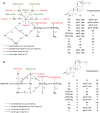Thermal transformation of polar into less-polar ginsenosides through demalonylation and deglycosylation in extracts from ginseng pulp
- PMID: 33452317
- PMCID: PMC7810680
- DOI: 10.1038/s41598-021-81079-w
Thermal transformation of polar into less-polar ginsenosides through demalonylation and deglycosylation in extracts from ginseng pulp
Abstract
The present study was conducted to qualitatively and quantitatively elucidate dynamic changes of ginsenosides in ginseng pulp steamed under different temperatures (100 or 120 °C) for different durations (1-6 h) through UPLC-QTOF-MS/MS and HPLC with the aid of as numerous as 18 authentic standards of ginsenosides. Results show that levels of eight polar ginsenosides (i.e., Rg1, Re, Rb1, Rc, Rb2, Rb3, F1, and Rd) declined but those of 10 less-polar ginsenosides [i.e., Rf, Rg2, 20(S)-Rh1, 20(R)-Rg2, F4, 20(S)-Rg3, 20(R)-Rg3, PPT, Rg5, and 20(R)-Rh2] elevated with increases of both steaming temperature and duration; the optimum steaming conditions for achieving the highest total ginsenosides were 100 °C for 1 h. Particular, 20(R)-Rg3, a representative less-polar ginsenoside with high bioactivity such as potent anti-cancer effect, increased sharply but Re, the most abundant polar ginsenoside in fresh ginseng pulp, decreased dramatically. More importantly, ginsenoside species enhanced from 18 to 42 after steaming, mainly due to transformation of polar into less-polar ginsenosides. Furthermore, four malonyl-ginsenosides were detected in fresh ginseng pulps and ten acetyl-ginsenosides were formed during steaming, demonstrating that demalonylation and acetylation of ginsenosides were the dominant underling mechanisms for transformation of polar into less-polar ginsenosides.
Conflict of interest statement
The authors declare no competing interests.
Figures




Similar articles
-
Diversity of Ginsenoside Profiles Produced by Various Processing Technologies.Molecules. 2020 Sep 24;25(19):4390. doi: 10.3390/molecules25194390. Molecules. 2020. PMID: 32987784 Free PMC article. Review.
-
Intraconversion of Polar Ginsenosides, Their Transformation into Less-Polar Ginsenosides, and Ginsenoside Acetylation in Ginseng Flowers upon Baking and Steaming.Molecules. 2018 Mar 26;23(4):759. doi: 10.3390/molecules23040759. Molecules. 2018. PMID: 29587462 Free PMC article.
-
Simultaneous determination of 30 ginsenosides in Panax ginseng preparations using ultra performance liquid chromatography.J Ginseng Res. 2013 Oct;37(4):457-67. doi: 10.5142/jgr.2013.37.457. J Ginseng Res. 2013. PMID: 24235860 Free PMC article.
-
Remarkable impact of steam temperature on ginsenosides transformation from fresh ginseng to red ginseng.J Ginseng Res. 2018 Jul;42(3):277-287. doi: 10.1016/j.jgr.2017.02.003. Epub 2017 Feb 27. J Ginseng Res. 2018. PMID: 29983609 Free PMC article.
-
Comparison of the pharmacological effects of Panax ginseng and Panax quinquefolium.Acta Pharmacol Sin. 2008 Sep;29(9):1103-8. doi: 10.1111/j.1745-7254.2008.00868.x. Acta Pharmacol Sin. 2008. PMID: 18718179 Review.
Cited by
-
A Comparative Study on Analysis of Ginsenosides in American Ginseng Root Residue by HPLC-DAD-ESI-MS and UPLC-HRMS-MS/MS.Molecules. 2022 May 11;27(10):3071. doi: 10.3390/molecules27103071. Molecules. 2022. PMID: 35630548 Free PMC article.
-
Compositional changes and physiological activities of fresh ginseng extracts prepared at various temperatures in subcritical water.J Ginseng Res. 2025 Jan;49(1):64-70. doi: 10.1016/j.jgr.2024.09.007. Epub 2024 Sep 24. J Ginseng Res. 2025. PMID: 39872291 Free PMC article.
-
Effects of Different Drying Methods on the Quality of Forest Ginseng Revealed Based on Metabolomics and Enzyme Activity.Foods. 2025 Aug 7;14(15):2753. doi: 10.3390/foods14152753. Foods. 2025. PMID: 40807690 Free PMC article.
-
Ginsenosides from Panax ginseng as Key Modulators of NF-κB Signaling Are Powerful Anti-Inflammatory and Anticancer Agents.Int J Mol Sci. 2023 Mar 24;24(7):6119. doi: 10.3390/ijms24076119. Int J Mol Sci. 2023. PMID: 37047092 Free PMC article. Review.
-
Rare ginsenosides: A unique perspective of ginseng research.J Adv Res. 2024 Dec;66:303-328. doi: 10.1016/j.jare.2024.01.003. Epub 2024 Jan 7. J Adv Res. 2024. PMID: 38195040 Free PMC article. Review.
References
-
- Singh P, Kim YJ, Wang C, Mathiyalagan R, Yang DC. The development of a green approach for the biosynthesis of silver and gold nanoparticles by using Panax ginseng root extract, and their biological applications. Artif. Cells. Nanomed. Biotechnol. 2016;44:1150–1157. - PubMed
-
- Liu J, et al. The integration of GC-MS and LC-MS to assay the metabolomics profiling in Panax ginseng and Panax quinquefolius reveals a tissue- and species-specific connectivity of primary metabolites and ginsenosides accumulation. J. Pharm. Biomed. Anal. 2017;135:176–185. doi: 10.1016/j.jpba.2016.12.026. - DOI - PubMed
Publication types
LinkOut - more resources
Full Text Sources
Other Literature Sources
Miscellaneous

